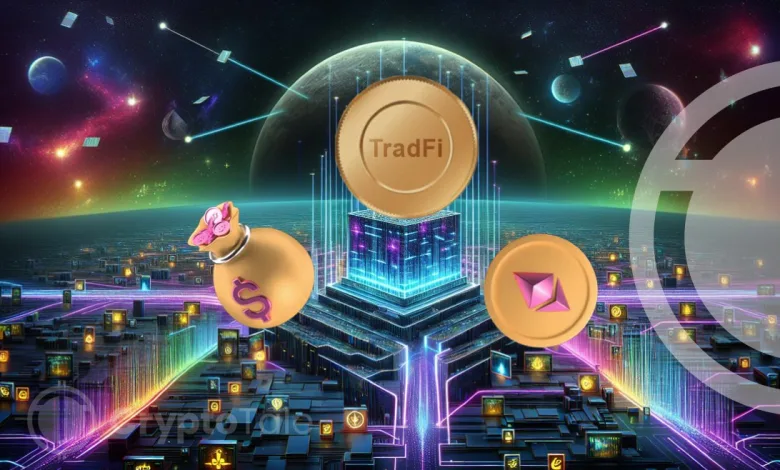TradFi and Crypto: Exploring Strengths and Challenges

The combination of TradFi and cryptocurrency has sparked many ideas into discussions regarding the future of the financial industry. This article provides a deep insight into TradFi’s role in the cryptocurrency space by exploring its functions, strengths, and challenges it faces with decentralized finance (DeFi) and centralized finance (CeFi).
What is TradFi?
TradFi, the short form of traditional finance, refers to the traditional financial system consisting of banks, government-issued currencies (fiat money), stock exchanges, and regulated financial institutions. These entities follow rules, policies, and regulatory measures, aiming to enhance investors and promote financial stability.
While TradFi uses intermediaries like banks, brokerages, or even regulatory bodies, the cryptocurrency space applies decentralization and peer-to-peer transactions as an alternative.
Functions of TradFi
TradFi serves several critical functions that sustain the global economy:
Capital Allocation: Banks and financial institutions act as middlemen and help in the process of lending and borrowing of capital. They assist the companies in financing through loans, bonds, and share sales.
Wealth Management: Tradfi offers services like investment portfolios, retirement planning, and savings accounts among others. These services help individuals and organisations to accumulate and build up their capital assets.
Payment System: The traditional financial system provides a safe and secure method for transactions, especially cross-border transactions. Money transfers, credit and debit cards, use of bank accounts can be made effective with this method.
Risk Management: TradFi offers several ways of dealing with financial risks, including insurance, hedging, and future contracts. These services play a pivotal role in minimizing and managing losses that could be incurred.
Regulation and Oversight: Financial regulations in TradFi guarantee safe, transparent, and secure operations, ensuring stability within the financial market.
Strengths of TradFi
Despite the rise of cryptocurrency and DeFi, TradFi has several inherent strengths that continue to sustain its relevance. They are:
Trust and Security: TradFi’s reputation for security and stability reassures individuals and businesses. The banking institutions are affiliated with government support enabling them to mitigate risks like fraud or financial crimes.
Regulation and Compliance: They help to maintain coordination when financial entities are undertaking their operations. This will benefit investors and the overall market and prevent fraud, thereby stabilizing the economy.
Global Reach: TradFi provides tools for payment processing, lending, investment, enabling companies’ operations on an international level.
Challenges
Just as the strengths of TradFi boost the economy, there are a few challenges faced by it, especially in blockchain and cryptocurrency. These include:
High Costs: The traditional financial system imposes high costs for transfers, cross border payments, loans, and other wealth management services. Also, some fees charged by intermediaries like the bank can be prevented for small shareholders or companies.
Centralization of Power: Mostly, the control is in the hands of large enterprises which can lead to inefficiencies and potential systemic risks. This centralization implies that various kinds of financial crises can affect people greatly.
Limited Access: On a global level, many lack access to banking systems. This has reduced the ability of millions of people in the developing world to do business in the global market.
Slow in Innovation: Another key problem of TradFi is its capacity to adapt to new technologies and innovation solutions. This results in the creation of outdated services that lack innovation, and a lack of competition, leading to a stagnant market with few or no alternative options for consumers.
Comparing Decentralized Finance and Traditional Finance
Decentralized Finance (DeFi) is an emerging concept within the cryptocurrency space. It aims at disrupting TradFi because it utilizes blockchain technology to perform financial transactions without third parties. The DeFi works on decentralized apps and smart contracts which help in avoiding middlemen like banks, brokers, and financial institutions. Some of the differences between DeFi and TradFi are:
Intermediaries: In TradFi, there are intermediaries such as banks that people trust, whereas in DeFi, it uses smart contracts and decentralized protocols.
Access: DeFi platforms are open to anyone with an internet connection. But, TradFi expects users to meet specific qualifications for accessing services.
Transparency: This is a challenge as DeFi transactions are recorded on public blockchains which means they are fully transparent and can be audited. However, tradFi involves several checks and most of the operations are kept within internal systems.
Regulation: While the traditional finance system is tightly controlled by governments and financial bodies, the decentralized finance system is an unregulated environment.
Comparing Centralized Finance and Traditional Finance
Unlike DeFi that is fully decentralized, centralized finance (CeFi) has numerous benefits of decentralized assets while retaining some of the principles of tradFi. Some CeFi platforms are centralized exchanges (CEXs) that bring in familiar financial services to users. Some of the differences between CeFi and TradFi are:
Digital Assets: While tradFi involves fiat money, CeFi engages in cryptocurrencies like Bitcoin, Ethereum, and other tokens.
Custody and Control: CeFi users cannot directly control the forms of their keys as exchanges are solely responsible for custody. In TradFi, financial institutions act as custodians of the client’s money and other assets.
Regulatory Environment: CeFi functions in an environment following the rules and regulations for AML, KYC. However, TradFi complies with internationally recognized financial regulations.
Accessibility and Innovation: CeFi is faster in innovation than TradFi because the latter is slow and rigid.
Conclusion
TradFi continues to be a huge part of the global financial system serving an important role in the economy. It provides trust, security, and regulatory compliance, even though it has its drawbacks. However, having a closer look at TradFi, DeFi, and CeFi shows the evolving landscape of finance and the role that each system plays in shaping the future.




